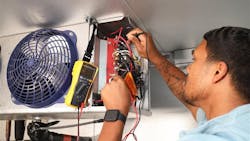Evaluating and Solving Common Cooler and Freezer Problems
For service technicians in the field, no two service calls are exactly alike. Refrigeration issues often stem from a combination of causes rather than a single, clear-cut failure. Temperature fluctuations, ice buildup, compressor malfunctions, and water leaks are among the most common problems found in commercial coolers and freezers. Knowing how to identify and resolve these issues quickly can prevent costly downtime, reduce energy consumption, and extend equipment life.
Refrigeration Red Flags
One of the most frequent complaints from operators is inconsistent temperature control. When a cooler or freezer struggles to maintain proper temperatures, the root cause often can be traced to a mis-calibrated thermostat, restricted airflow, or door seals that no longer hold a proper seal.
Overloaded shelves and blocked evaporator fans can severely disrupt airflow, causing some areas to become too warm while others drop below the setpoint. Ice-covered evaporator coils present another common culprit, leading to inefficient heat exchange and erratic temperature readings.
In these cases, technicians should verify that the thermostat is functioning correctly before addressing airflow restrictions and potential coil icing. Regularly inspecting and replacing worn door gaskets can prevent warm air from infiltrating the system and throwing off temperature consistency.
Excessive frost or ice buildup is another red flag that often points to humidity issues or a failing defrost cycle. Frequent door openings allow moisture-laden air to enter the unit, leading to frost accumulation on the evaporator. If left unchecked, this can result in ice blockages that restrict airflow and force the compressor to work harder than necessary. Malfunctioning defrost cycles exacerbate the problem, as ice buildup that isn't properly melted during the defrost phase can eventually lead to frozen coils.
If ice accumulation is severe, check the defrost timer, heaters, and termination switch to determine if the system is operating as intended. Additionally, inspect the door seals for leaks, as damaged gaskets can allow warm, humid air to enter and contribute to frost formation.
Compressor failures are another frequent issue, often stemming from poor maintenance or electrical problems. When diagnosing compressor issues, a thorough inspection of the refrigeration system is necessary to pinpoint the root cause. Cleaning condenser coils, verifying proper refrigerant charge, and checking electrical components can help restore compressor function and prevent further damage.
Excessive moisture in a refrigerated space can stem from multiple sources. Improper defrost settings may cause residual water on the coil to steam, leading to condensation on walls, ceilings, and floors. Water leaks inside or around the refrigeration unit often indicate clogged or frozen drain lines. Flush drain lines regularly to prevent blockages from debris or ice buildup. Excessive condensation on doors and gaskets suggests warm air infiltration due to poorly sealed doors or improperly sealed barometric dampers, allowing warm, humid air to enter the box. Check gasket integrity, hinge alignment, and damper function to ensure a proper seal.
Unusual noises from a refrigeration system often serve as early warning signs of mechanical wear or refrigerant issues. Rattling and grinding sounds may indicate failing fan motors or worn compressor bearings, while hissing noises can suggest refrigerant leaks or restrictions. Identifying and addressing these problems early can prevent more serious damage down the line.
A refrigeration system that runs inefficiently will draw more power than necessary, driving up energy costs while putting excessive strain on its components. Regularly clean the evaporator and condenser coils, replace worn door seals, and optimize temperature setpoints based on product load to improve efficiency and lower operating costs.
Preventing Problems Before They Start
The key to preventing costly breakdowns is a strong preventative maintenance program. Routine inspections of critical components — such as coils, fans, door seals, and drain lines — can help identify potential failures before they escalate. Adhere to cleaning schedules to remove dust, grease, and ice accumulation that can compromise efficiency. Monitor performance trends, including temperature fluctuations and defrost cycle effectiveness, to spot inconsistencies and address them proactively. Additionally, check electrical connections, relays, and contactors for signs of wear to help prevent sudden system failures.
Ultimately, keeping commercial coolers and freezers in top condition requires a combination of regular maintenance and prompt troubleshooting. By addressing small problems before they turn into major failures, technicians can help businesses maintain efficient refrigeration systems, reduce service calls, and extend equipment life. In an industry where uptime is critical, staying ahead of potential failures can make all the difference.
About the Author
Chris Thomas
Chris Thomas is the supervisor of Product Services at Heatcraft Refrigeration Products.
